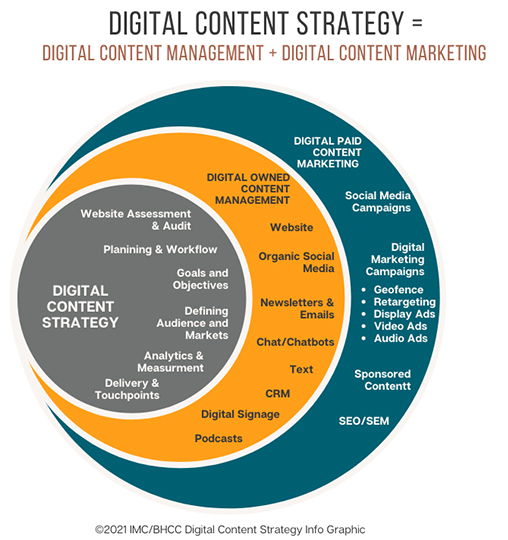Twenty months ago, Covid-19 flipped our worlds and drove us to rely even more on digital technologies to communicate, learn, work, shop and stay connected. During the early months of the pandemic, higher education moved to mostly remote learning, making digital tools and technology more critical than ever. Now, even as college campuses open more in-person learning, there’s a new expectation and acceptance for online options to be available.
This article is part of a monthly series provided by the National Council for Marketing & Public Relations, an affiliated council of the American Association of Community Colleges.
When the pandemic hit, Boston went quiet, so it became imperative for the integrated marketing and communications division at Bunker Hill Community College (BHCC) to assess the role of digital channels in its content strategy. The division paused paid print advertising on city transit and billboards and focused promotional efforts on digital media. Its experience led to some best practices – which the Boston college still employs – that can be used by other colleges for their strategic digital marketing efforts.
Audience diving
The first step of community college communications planning is to study generational cohorts and map them to community college demographics. The American Association of Community Colleges’ Fast Facts 2021 reports the following:
- The average age for a community college student is 28, and the median age is 24.
- 56% of students are younger than 22.
- 36% are between 22 and 39.
- 8% are older than 40.
That means the vast majority of community college students are Millennials and Generation Z, or born between 1981 and 1996 and after 1996, respectively.
Knowledge of each generational group’s characteristics will help college employees develop marketing and communications strategies to reach current and future students. For example, both Millennials and Gen Zers share digital prowess. The former witnessed the birth of digital technology; and Gen Zers, often called digital natives, were born when digital technology and social media were at their peak.
Members of Gen Z are on track to be the most well-educated generation and are more racially and ethnically diverse than other generations, according to the Pew Research Center. Both generations want to get their information online, especially via smartphone. It follows that, when making purchasing decisions, they tend to use technology for research, looking to real-life people and social media networks in lieu of traditional advertising.
Content strategy
Studying demographics, life experience and cultural wealth can help marketers reach their target audience. Content strategy remains vital in the digital world. It’s essential for marketers to identify their audience, stakeholders and goals before launching a campaign; so a digital communications audit may be in order to assess whether college marketing teams have the right content. Before starting any project or campaign, consider all areas where the content may appear so the same message is broadcast across outlets.
No matter what activity paid media generates, it leads back to the website and other owned content posted on social media. So before paying for advertising, marketers should focus on their owned digital content, beginning with the website, which is the No. 1 marketing and retention tool in the content management toolkit.
These three steps can help maximize audience engagement:

- Determine who needs what. Educational institutionsoften try to make websites all things to all people, which means those sites don’t meet any of their audience’s needs. Depending on where a college site is in its evolution, gathering information is important. Conduct focus groups, host live and online surveys and interview stakeholders — including current students, future students, faculty, staff, business partners, community-based organizations, government, media and community. This can help marketers reach the right segment with the right content. When BHCC conducted this exercise as part of a recent website assessment, it discovered that the hierarchy of informational needs differs between students and non-students.
- Make the website mobile-friendly with digital-first in mind. A college website needs a responsive design to transform content into a format easily accessed on a mobile phone. Since there’s less real estate on a phone screen, marketers should review the order of content on mobile versus desktop; some key information may fall to the bottom of a phone screen if the website is not properly coded for mobile. If that happens, colleges can miss opportunities to engage their audience.
- Connect using your institutional social media accounts. These are your conduits to share content, create authentic multi-way conversations and share calls-to-action to drive audiences back to the college website. The beauty of owned media is that colleges control their messages, share their stories and create engagement with their audiences. Marketers can, and should, engage their audience through other digital communication methods, too, including email, chat and text messages.
Digital content marketing
This is where things get a little more complicated. Digital content marketing provides data to help shape the content strategy required to reach future students. Paid advertising will usually have a call-to-action that drives viewers to the website. Think of “paid” as an acronym: Please aid in delivery.
One upside of today’s digital marketing tactics is that they provide a view into where people are seeing ads — mobile, laptop or desktop — which shapes the college digital content strategy. Plus, using data collected by following digital trails can provide key metrics that illustrate the value of digital marketing. Digital marketing campaign reports offer a wealth of information to drive further targeted campaigns to the audience. Marketers can track if ads get users to click, visit the website or apply. This provides ROI that didn’t exist in the analog marketing world.
Whether colleges are looking to market, promote or communicate, marketers should know their audience and how to reach them. Before using the next shiny new digital tactic that comes along, see what’s in place and start there. This isn’t about abandoning traditional mediums and tactics but preparing for the future.





